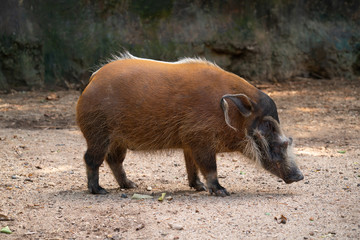ANIMAL: Red River Hog Potamochoerus porcus Type of Animal: Wild Pig Habitat: Forests, savannahs (open & wooded), forested valleys, thickets, swamps, areas around rivers/lakes/marshes, brush, cultivated areas, grasslands, steppe, human villages Location(s): W & C Africa Appearance: Orange to reddish-brown coloration w/ black legs & tufted white stripe along spine, white markings around eyes & on cheeks/jaws, rest of face/muzzle black, boars larger w/ bumpier snout & more noticeable facial whiskers, tasseled ears, piglets born dark brown w/ yellowish stripes/spots Food/Diet: Roots, fruit, seeds, crops, roots, tubers, root vegetables, corn, grasses, nuts, bulbs, herbs, eggs, invertebrates, reptiles, carrion, elephant poop, water plants, berries, birds, mammals up to size of small goats/sheep Status in Wild: Stable Conservation: Breeding from zoos & wildlife parks Lifestyle: Sounders consist of boar w/ 1-5 sows & offspring, sometimes up to 10 sows & offspring. Related males sometimes found in bachelor groups. Aggregations sometimes occur among this species. Additional Info: Called: Male-Boar Female-Sow Young-Piglet Group-Sounder Weight: Male-250 lbs Female-100 lbs Young-5-8 lbs Gestation: 4 months Life Span: 15 years Height: Male-2.58 ft Female-1.83 ft Body Length: Male-4.75 ft Female-3.25 ft Tail Length: 1-1.5 ft Main predators are leopards, lions, hyenas, wild dogs, crocodiles, pythons, cheetahs, & chimps. Often persecuted as crop pests & predators of small livestock. Increased in much of range due to lower predator populations, generalist diet, & adaptable nature. Excellent sense of touch & smell. Uses snout to burrow for food. Most active at night or at dusk, though often active during daytime as well. Boars sometimes fight to the death over harems by using sharper lower canine tusks. Sexually mature at a year old. Litters usually consist of 2-6 piglets. Usually communicate w/ grunts & squeals. Due to scent glands in feet & lips, they leave scent marks everywhere they go. Get their name from red coat & tendency to wallow in rivers. Fun Fact(s): They’re excellent swimmers & fast runners. While they prefer to flee, they’re highly dangerous when cornered & whole group highly protective of piglets. Sometimes called bush pigs. It’s closest relative is actually the African Bush Pig. They’re a carrier of African Swine Fever, which is derived from ticks & fatal to domestic pigs. They’ll follow primates (including chimps) in search of fallen fruit. Blow breath on each other as form of greeting. When piglets frightened, they crouch & play dead.
